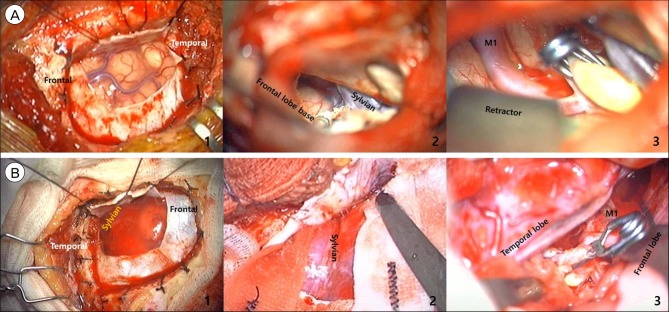J Cerebrovasc Endovasc Neurosurg.
2016 Mar;18(1):5-11. 10.7461/jcen.2016.18.1.5.
Modified Supraorbital Keyhole Approach to Anterior Circulation Aneurysms
- Affiliations
-
- 1Department of Neurosurgery, Gachon University Gil Medical Center, Incheon, Korea. nschan@gilhospital.com
- 2Department of Radiation Oncology, Wonju College of Medicine, Yonsei University, Wonju, Korea.
- KMID: 2161696
- DOI: http://doi.org/10.7461/jcen.2016.18.1.5
Abstract
OBJECTIVE
To select a surgical approach for aneurysm clipping by comparing 2 approaches.
MATERIALS AND METHODS
204 patients diagnosed with subarachnoid hemorrhage treated by the same neurosurgeon at a single institution from November 2011 to October 2013, 109 underwent surgical clipping. Among these, 40 patients with Hunt and Hess or Fisher grades 2 or lower were selected. Patients were assigned to Group 1 (supraorbital keyhole approach) or Group 2 (modified supraorbital approach). The prognosis according to the difference between the two surgical approaches was retrospectively compared.
RESULTS
Supraorbital keyhole approach (Group 1) was performed in 20 aneurysms (50%) and modified supraorbital approach (Group 2) was used in 20 aneurysms. Baseline characteristics of patients did not differ significantly between two groups. Total operative time (p = 0.226), early ambulation time (p = 0.755), length of hospital stay (p = 0.784), Glasgow Coma Scale at discharge (p = 0.325), and Glasgow Outcome Scale scores (p = 0.427) did not show statistically significant differences. The amount of intraoperative hemorrhage was significantly lower in the supraorbital keyhole approach (p < 0.05).
CONCLUSION
The present series demonstrates the safety and feasibility of the two minimal invasive surgical techniques for clipping the intracranial aneurysms. The modified supraorbital keyhole approach was associated with more hemorrhage than the previous supraorbital keyhole approach, but did not exhibit differences in clinical results, and provided a better surgical view and convenience for surgeons in patients with Hunt and Hess or Fisher grades 2 or lower.
MeSH Terms
Figure
Cited by 1 articles
-
Keyhole approach in anterior circulation aneurysm: Current indication, advantages, technical limitations, complications and their avoidance
Hanuman Prajapati, Ahmad Ansari, Manish Jaiswal
J Cerebrovasc Endovasc Neurosurg. 2022;24(2):101-112. doi: 10.7461/jcen.2022.E2021.07.008.
Reference
-
1. Berhouma M, Jacquesson T, Jouanneau E. The fully endoscopic supraorbital trans-eyebrow keyhole approach to the anterior and middle skull base. Acta Neurochir (Wien). 2011; 10. 153(10):1949–1954. PMID: 21818644.
Article2. Bhatoe HS. Transciliary supraorbital keyhole approach in the management of aneurysms of anterior circulation: Operative nuances. Neurol India. 2009; Sep-Oct. 57(5):599–606. PMID: 19934559.
Article3. Brock M, Dietz H. The small frontolateral approach for the microsurgical treatment of intracranial aneurysms. Neurochirurgia (Stuttg). 1978; 11. 21(6):185–191. PMID: 724020.
Article4. Chehrazi BB. A temporal transsylvian approach to anterior circulation aneurysms. Neurosurgery. 1993; 7. 33(1):172. PMID: 8355840.
Article5. Chen HC, Tzaan WC. Microsurgical supraorbital keyhole approach to the anterior cranial base. J Clin Neurosci. 2010; 12. 17(12):1510–1514. PMID: 20817469.
Article6. Cheng CM, Noguchi A, Dogan A, Anderson GJ, Hsu FP, McMenomey SO, et al. Quantitative verification of the keyhole concept: a comparison of area of exposure in the parasellar region via supraorbital keyhole, frontotemporal pterional, and supraorbital approaches. J Neurosurg. 2013; 2. 118(2):264–269. PMID: 23140145.
Article7. Czirják S, Szeifert GT. Surgical experience with frontolateral keyhole craniotomy through a superciliary skin incision. Neurosurgery. 2001; 1. 48(1):145–149. discussion 149-50PMID: 11152339.
Article8. Dare AO, Landi MK, Lopes DK, Grand W. Eyebrow incision for combined orbital osteotomy and supraorbital minicraniotomy: Application to aneurysms of the anterior circulation. Technical note. J Neurosurg. 2001; 10. 95(4):714–718. PMID: 11596969.9. Güresir E, Schuss P, Vatter H, Raabe A, Seifert V, Beck J. Decompressive craniectomy in subarachnoid hemorrhage. Neurosurg Focus. 2009; 6. 26(6):E4. PMID: 19485717.
Article10. Jane JA, Park TS, Pobereskin LH, Winn HR, Butler AB. The supraorbital approach: technical note. Neurosurgery. 1982; 10. 11(4):537–542. PMID: 7145070.
Article11. Ormond DR, Hadjipanayis CG. The supraorbital keyhole craniotomy through an eyebrow incision: Its origins and evolution. Minim Invasive Surg. 2013; 2013:296469. PMID: 23936644.
Article12. Paine JT, Batjer HH, Samson D. Intraoperative ventricular puncture. Neurosurgery. 1988; 6. 22(6 Pt 1):1107–1109. PMID: 3419576.
Article13. Paladino J, Pirker N, Stimac D, Stern-Padovan R. Eyebrow keyhole approach in vascular neurosurgery. Minim Invasive Neurosurg. 1998; 12. 41(4):200–203. PMID: 9932263.
Article14. Park J, Hamm IS. Revision of paine's technique for intraoperative ventricular puncture. Surg Neurol. 2008; 11. 70(5):503–508. discussion 508PMID: 18295826.
Article15. Sanchez-Vazquez MA, Barrera-Calatayud P, Mejia-Villela M, Palma-Silva JF, Juan-Carachure I, Gomez-Aguilar JM, et al. Transciliary subfrontal craniotomy for anterior skull base lesions. Technical note. J Neurosurg. 1999; 11. 91(5):892–896. PMID: 10541254.16. Steiger HJ, Schmid-Elsaesser R, Stummer W, Uhl E. Transorbital keyhole approach to anterior communicating artery aneurysms. Neurosurgery. 2001; 2. 48(2):347–351. discussion 351-2PMID: 11220378.
Article17. Trivedi DJ, Shrimankar PS, Kariya VB, Pensi CA. A study of supraorbital notches and foramina in gujarati human skulls. Natl J Integr Res Med. 2010; Jul-Sep. 1(3):1–6.18. van Lindert E, Perneczky A, Fries G, Pierangeli E. The supraorbital keyhole approach to supratentorial aneurysms: concept and technique. Surg Neurol. 1998; 5. 49(5):481–489. PMID: 9586924.
Article19. Wilson DH. Limited exposure in cerebral surgery. Technical note. J Neurosurg. 1971; 1. 34(1):102–106. PMID: 4924207.20. Wongsirisuwan M, Ananthanandorn A, Prachasinchai P. The comparison of conventional pterional and transciliary keyhole approaches: Pro and con. J Med Assoc Thai. 2004; 8. 87(8):891–897. PMID: 15471292.21. Yasargil MG, Fox JL. The microsurgical approach to intracranial aneurysms. Surg Neurol. 1975; 1. 3(1):7–14. PMID: 1111150.
- Full Text Links
- Actions
-
Cited
- CITED
-
- Close
- Share
- Similar articles
-
- Microsurgical Experience with Supraorbital Keyhole Operations on Anterior Circulation Aneurysms
- Supraorbital Keyhole Approach for Intracranial Aneurysms : Transitioning from Concerns to Confidence
- Superciliary Keyhole Approach for Unruptured Anterior Circulation Aneurysms: Surgical Technique, Indications, and Contraindications
- Trans-supraorbital Approach to Anterior Circulation Aneurysms
- Keyhole Approach and Neuroendoscopy for Cerebral Aneurysms



